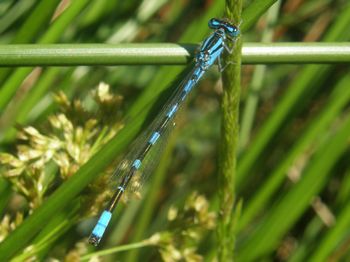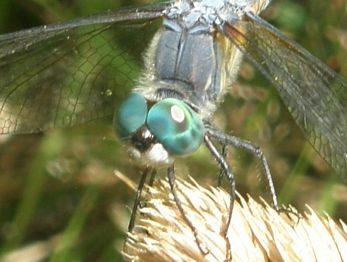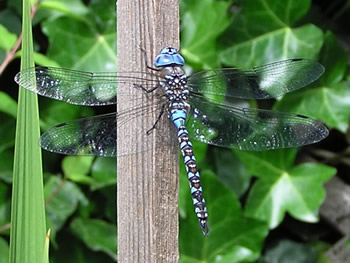|
__ |
|
There are over 5000 species of dragonflies and damselflies in the world. Over 400 are found in North America. |
|
Dragonflies have been around for over 300 million years. Huge ones were flying about while the dinosaurs roamed. |
| |
|
|
|
|
|
Dragonflies and damselflies belong to an order of carnivorous insects called Odonata which means "tooth jaws." The name Dragonfly, generally applies to both dragonflies and damselflies. |
|
Dragonflies and damselflies are characterized by their very small antennae, extremely large eyes, four transparent net-veined wings and long, slender body. |
| |
|
|
|
|
|
Dragonflies are in a subgroup of Odonata called Anisoptera which means "unequal wings." The hindwings of dragonflies are broader then their forewings. |
|
Damselflies belong to another subgroup of Odonata called Zygoptera which means "joined wings." Dameselflies have equal-sized wings which they usually hold together above the body when at rest. |
| |
|
|
|
|
|
When dragonflies rest, their wings are spread apart. |
|
Dragonflies only flap their wings at about 30 beats per second (compared to bees, which flap their wings at 300 times a second.) |
| |
|
|
|
|
|
Dragonflies usually beat their forewings and hindwings separately. When the forewings are up, the hindwings are down. |
|
The wings of dragonflies also have independent control allowing the insect to maneuver quickly, upwards, backwards, downwards, sideways and forwards. |
| | |
|
|
|
|
|
Dragonflies are amongst the fastest flying insects in the world with some going at almost 40 mph/60 km/h. |
|
Dragonfly eyes contain up to 30,000 individual lenses. The two large eyes give the insect almost 360° vision. |
| |
|
|
|
|
|
The eyes of most dragonflies touch. |
|
The eyes of damselflies don’t touch. |
| |
|
|
|
|
|
Like all insects, dragonflies have six legs but they can’t walk very well. |
|
Dragonflies hunt prey usually by catching it with their long legs. |
| |
|
|
|
|
|
Adult dragonflies mostly eat other flying insects like mosquitoes, flies, and gnats but they also catch butterflies, moths and even smaller dragonflies. |
|
Dragonflies prefer to live around many types of fresh water, especially calm, still water like ponds and marshes although some like steams or lake shores.
|
| |
|
|
|
|
|
Water is extremely important to dragonflies. Females deposit their eggs in or on water or on aquatic plants. Dragonfly nymphs are called naiads and emerge from the eggs. They are wingless, have gills and will feed on aquatic insects and other invertebrates.
|
|
The dragonfly naiads will molt numerous times, 8 to 17 is some species although usually 10 to 14 depending on the species. The remaining exoskeleton is called an exuvia. This process of laying eggs to the final molt can take one or two years or even longer. |
| |
|
|
|
|
 |
When the naiad is ready for adulthood, it emerges from the water and does one last molt. The newly emerged adult dragonfly is called a teneral adult. It is extremely vulnerable and a weak flyer.
|
|
A few days after emerging, the adult's body will harden The adult dragonfly will not grow anymore, but it will age and change in appearance. The life span of the adult dragonfly is usually only a few months. |
| |
|
|
|
|
|
On hot days, some dragonflies perch with the tip of the abdomen pointing toward the sun. This reduces the area of the body exposed to direct sunlight and helps regulate body temperature by reducing overheating. |
|
Dragonflies are harmless to humans.
They do not sting (they have nothing to sting you with) or bite.
|
| |
|
|
|
|
|
Some dragonflies hunt by perching and waiting for prey to pass. The
Striped Meadowhawk, Sympetrum pallipes, for example, likes to perch on the ground. In fact, its genus name Sympetrum means "with rock." |
|
Darners belong to the family Aeshnidae. These are large, fast dragonflies usually with blue, yellow or green markings. They can be seen constantly hunting, dashing and darting here and there. |
|| |
|
|


.jpg)























